
The Villa Giulia, also known as Villa del Popolo, and as Villa Flor [1] is an urban public park, lying to the east of the Botanical Garden of Palermo, in the region of Sicily, Italy.

The Villa Giulia, also known as Villa del Popolo, and as Villa Flor [1] is an urban public park, lying to the east of the Botanical Garden of Palermo, in the region of Sicily, Italy.

The park was commissioned by magistrate D. Antonino La Grua e Talamanca, marquis of Regalmici, in 1777 with inspiration from Giovanni Meli. [1] Designed by Nicolò Palma, [1] the park is named after Giulia Guevara, wife of the then Viceroy of Sicily, Marcantonio Colonna, prince of Stigliano, and to whom the villa in this park was dedicated. [2] Construction began that year and was completed in 1778. [1] [3] It became Palermo's first public park. [4] It was extended and enlarged in 1866. [3]
The original entrance overlooking the Foro Italico is of a monumental neoclassical design. It has been permanently closed, however, so access to the garden is now obtained through the primary entrance on Lincoln Street. That gate area is less developed.
The heart of the villa is the dodecahedron fountain, featuring a sculpture of a dodecahedral marble clock created by the mathematician Lorenzo Federici, each face of the dodecahedron featuring a sundial. This is supported by a statue of Atlas by Ignazio Marabitti, set in the centre of a circular fountain. Decorations surrounding the fountain consist of various metal sculptures.

Around the central fountain are four exedra, designed by Giuseppe Damiani Almeyda and intended to be used for musical performances. The entire central square was originally used for musical and theatrical entertainment. [5]
The four corners contained round seating areas, though only two of these still exist. The avenues of the garden are lined with various busts depicting notable people in the city's history. [2]
Among the marble sculptures, the most significant is the "Fontana del Genio a Villa Giulia" - the Genius of Palermo which has become an emblem of the city, [6] built in 1778 by Ignazio Marabitti. [7]
From Spring 2003 until Autumn 2005 areas of the Garden were restored with pan-European funding. [5]
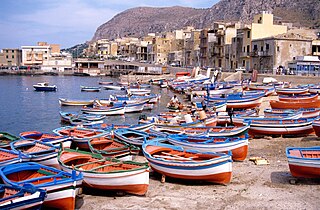
Bagheria is a city and comune in the Metropolitan City of Palermo in Sicily, Italy, located approximately 10km to the east of the city centre.

Villa Borghese is a landscape garden in Rome, containing a number of buildings, museums and attractions. It is the third-largest public park in Rome, after the ones of the Villa Doria Pamphili and Villa Ada. The gardens were developed for the Villa Borghese Pinciana, built by the architect Flaminio Ponzio, developing sketches by Scipione Borghese, who used it as a villa suburbana, or party villa, at the edge of Rome, and to house his art collection. The gardens as they are now were remade in the late 19th century.

The Villa Giulia is a villa in Rome, Italy. It was built by Pope Julius III in 1551–1553 on what was then the edge of the city. Today it is publicly owned, and houses the Museo Nazionale Etrusco, a collection of Etruscan art and artifacts.

Sicilian Baroque is the distinctive form of Baroque architecture which evolved on the island of Sicily, off the southern coast of Italy, in the 17th and 18th centuries, when it was part of the Spanish Empire. The style is recognisable not only by its typical Baroque curves and flourishes, but also by distinctive grinning masks and putti and a particular flamboyance that has given Sicily a unique architectural identity.

Francesco Camilliani was a Tuscan sculptor of the Renaissance period. He studied in Florence under Baccio Bandinelli. His son Camillo Camilliani was later a sculptor too, working in Palermo, where he also worked as an architect and held the post as well of ingegniere del Regno, "engineer to the Kingdom of Sicily".
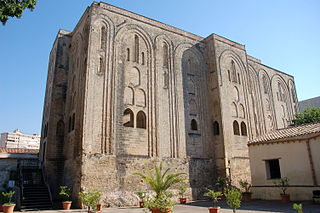
The Cuba is a recreational palace in the Sicilian city of Palermo, originally part of the Sollazzi Regi group of Norman palaces. It was built in 1180 by William II of Sicily in his Royal Park, together with an artificial lake. The name Cuba derives either from its cubical form, or the Arabic Qubba, "dome". It is an imitation of the Zisa palace. In July 2015 it was included in the UNESCO Arab-Norman Palermo and the Cathedral Churches of Cefalù and Monreale World Heritage Site.
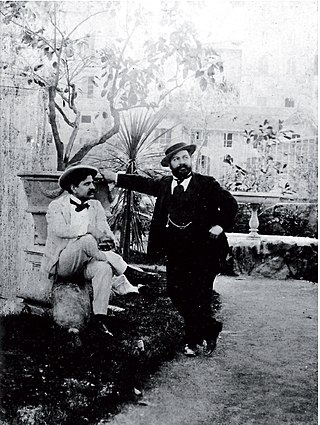
Mario Rutelli was an Italian sculptor.
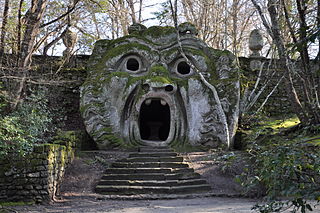
The Sacro Bosco, colloquially called Park of the Monsters, also named Garden of Bomarzo, is a Mannerist monumental complex located in Bomarzo, in the province of Viterbo, in northern Lazio, Italy.

The Palazzo Riso, or RISO, Museo d’Arte Contemporanea della Sicilia, is a regional contemporary art museum located in the ancient Corso Vittorio Emanuele, Palermo, Italy.

The Church of the Gesù, known also as the Saint Mary of Jesus or the Casa Professa, is a Baroque-style, Roman Catholic church established under the patronage of the Jesuit order, and located at Piazza Casa Professa 21 in Palermo, region of Sicily, Italy.

Ignazio Marabitti was a Sicilian sculptor of the late Baroque period.

The Fontana del Genio a Villa Giulia or Genio di Villa Giulia is a sculpted water fountain in the park of the Villa Giulia in Palermo. It was sculpted by Ignazio Marabitti in 1778 and shows the Genius of Palermo.

The Praetorian Fountain is a monumental fountain located in Piazza Pretoria in the historic center of Palermo, region of Sicily, Italy. The fountain dominates the piazza on the west flank of the church of Santa Caterina, and is one block south of the intersection of the Quattro Canti. The fountain was originally built in 1544 in Florence by Francesco Camilliani, but was sold, transferred, and reassembled in Palermo in 1574.

The Church of Saint Teresa is a Baroque Roman Catholic church, located on Piazza della Kalsa, facing the Porta de Greci in the ancient quarter of the Kalsa of the city of Palermo, region of Sicily, Italy.

Franca Florio, born Francesca Paola Jacona della Motta dei baroni di San Giuliano and commonly called Donna Franca, was an Italian noblewoman, socialite and a prominent protagonist of the Belle Époque. Descendant of a Sicilian noble family, she married the entrepreneur Ignazio Florio Jr., member of the wealthy Florio family. She was nicknamed "Queen of Palermo".
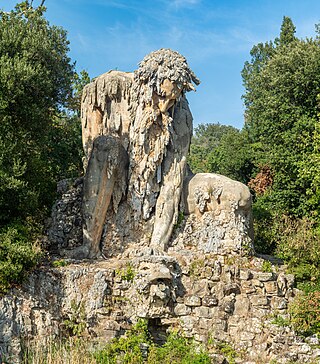
The Apennine Colossus is a stone statue, approximately 11 m high, in the estate of the Villa Demidoff in Vaglia, Tuscany in Italy. Giambologna created the colossal figure, a personification of the Apennine mountains, in the late 1580s. It was constructed on the grounds of the Villa di Pratolino, a Renaissance villa that fell into disrepair and was replaced by the Villa Demidoff in the 1800s.

The Fountain of the Genius of Fieravecchia is a historic fountain located in Piazza Rivoluzione in the ancient quarter of Kalsa in the historic center of Palermo, region of Sicily, Italy.

Kanaris at Chios, also known as The Kanaris brothers or The sailors of the English Garden, is a marble sculpture completed by Benedetto Civiletti in Palermo, Sicily in 1878. It represents Konstantinos Kanaris and Andreas Pipinos at Chios, as they were sailing on board a fireboat towards the Ottoman flagship of admiral Nasuhzade Ali Pasha. This event, known as the burning of the Ottoman flagship off Chios took place on the night of 18 June 1822 during the Greek War of Independence, and was a reprisal for the Chios massacre which occurred two months earlier. Two thousand Ottoman sailors were killed, including Nasuhzade Ali Pasha himself.
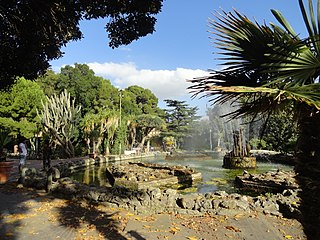
The Piersanti Mattarella Park, formerly the English Garden, is a public park in Palermo designed in 1851 by the architect Giovan Battista Filippo Basile.

The Elephant Fountain is a monument located in the center of Piazza del Duomo in the Sicilian city of Catania, designed by architect Giovanni Battista Vaccarini between 1735 and 1737. Its main element is a black basalt statue of an elephant, commonly called u Liotru, which has become the emblem of the city of Catania.